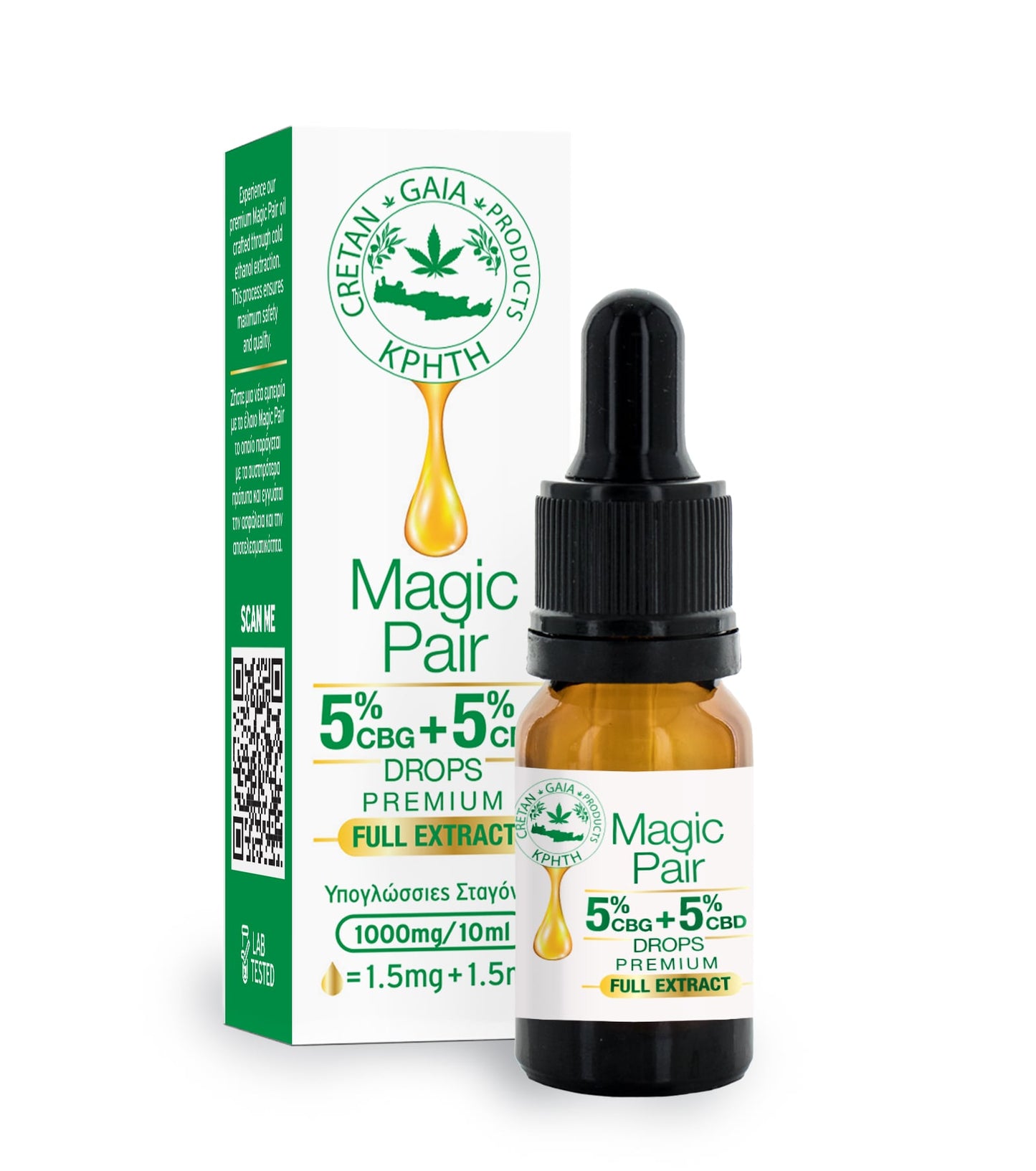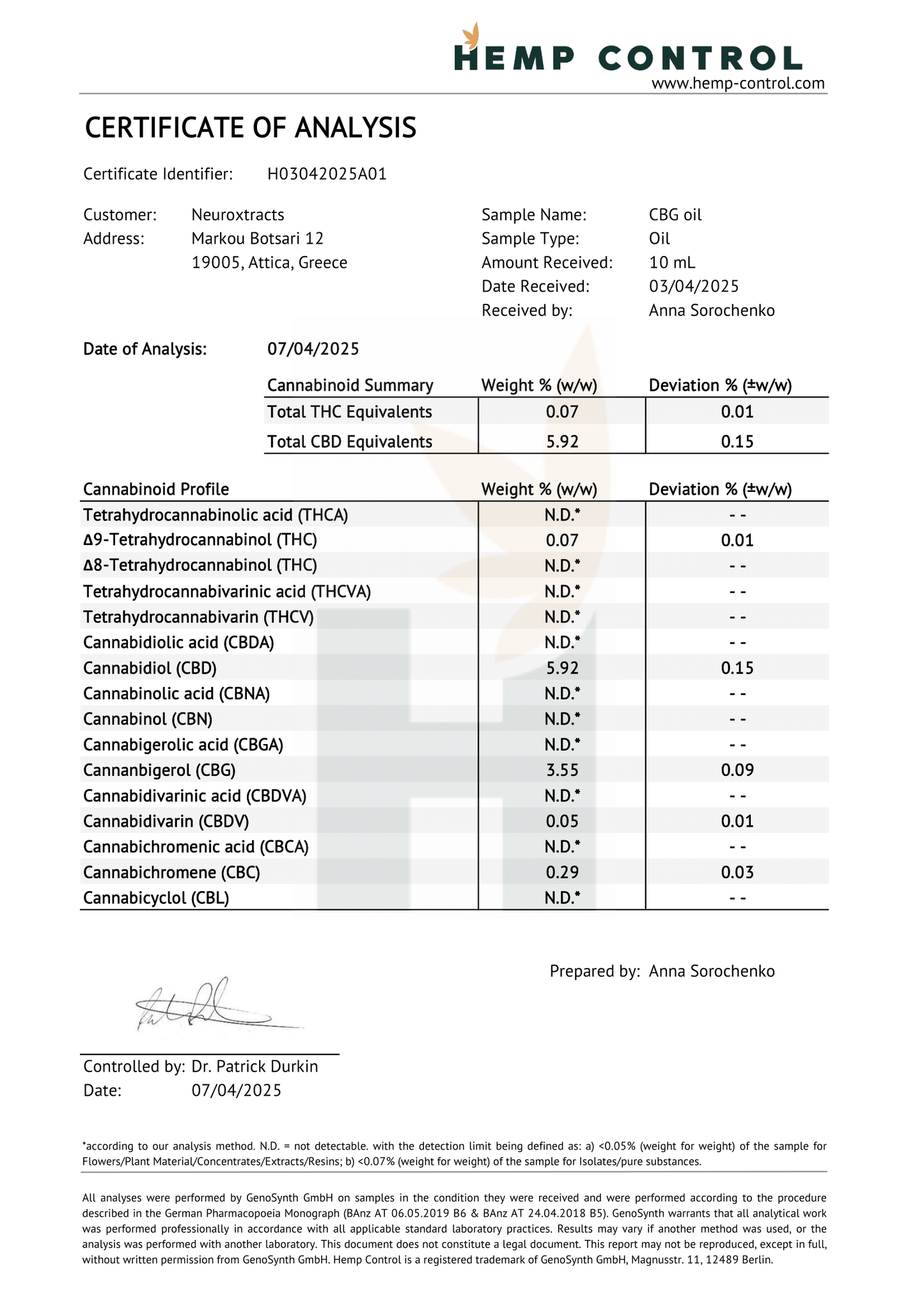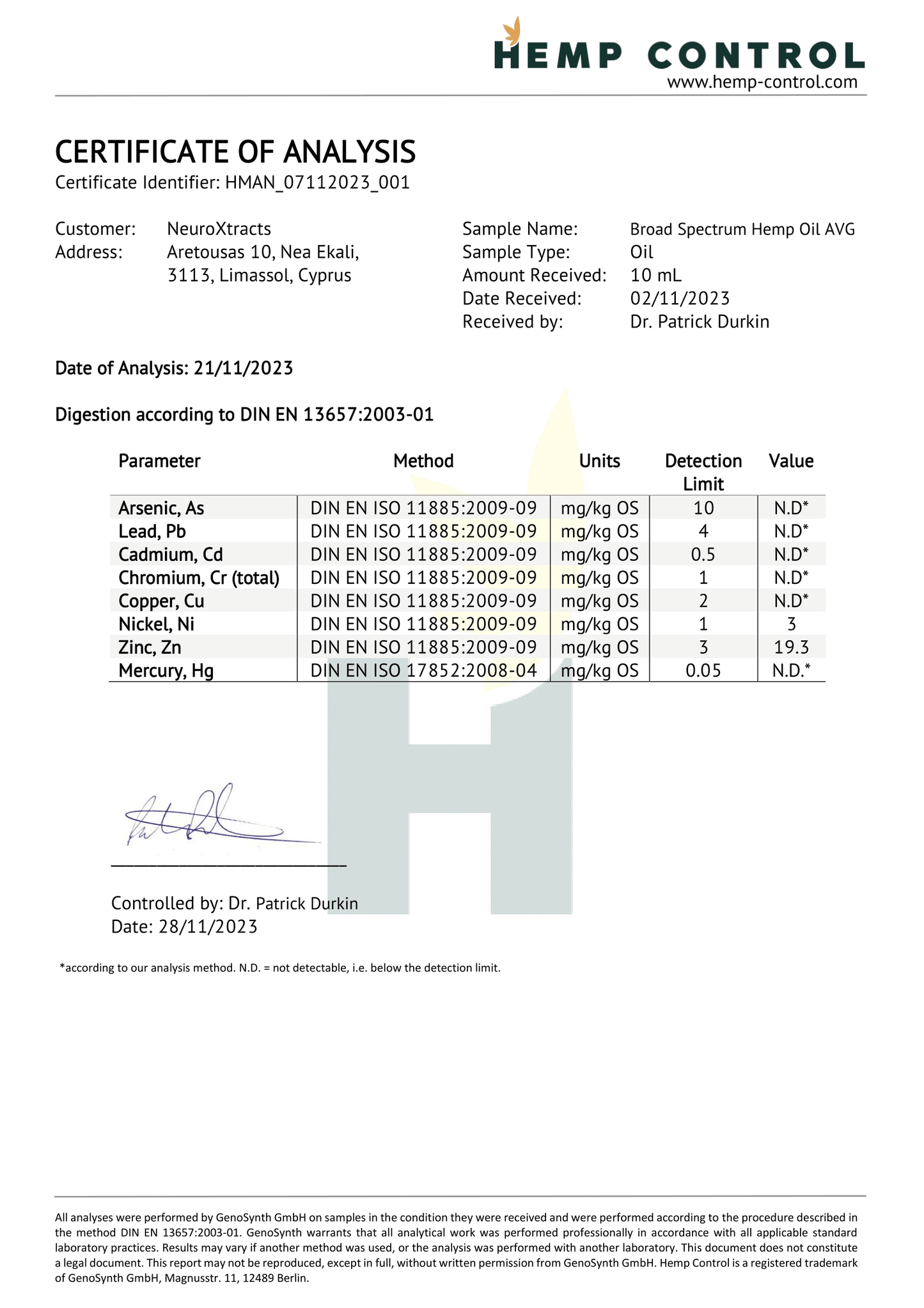CRETAN GAIA PRODUCTS
Cretan Gaia Full Extract Magic Pair Cannabis Oil – 5% CBD & 5% CBG, 10ml
Cretan Gaia Full Extract Magic Pair Cannabis Oil – 5% CBD & 5% CBG, 10ml
Couldn't load pickup availability
CRETAN GAIA Full Extract Magic Pair Oil 5% CBD & 5% CBG, 10ml
The CRETAN GAIA Magic Pair Oil combines CBD and CBG in equal concentration for a balanced full-extract formula. Carefully crafted from natural hemp extract, it provides a natural way to integrate phytocannabinoids into your daily oral care routine.
🧪 How to Use
• Shake well before use
• Apply a small amount 2–3 times daily, preferably every day
• Store in a cool, dark place at room temperature (15–25 °C)
Want to learn more about cannabidiol+cannabigerol combination and their properties in oral care and wellness products? Check out this short blog.
🧬 Cannabidiol (CBD) & Cannabigerol (CBG): Combined Benefits and Scientifically Documented Properties
Cannabidiol (CBD) and Cannabigerol (CBG) are two natural phytocannabinoids derived from the Cannabis sativa plant. CBD is one of the most prevalent cannabinoids found in hemp, while CBG is a minor cannabinoid often called the “parent” molecule (CBG-A is the precursor from which other cannabinoids like CBD and THC form). Importantly, both CBD and CBG are non-psychoactive, meaning they do not produce a “high” or intoxication. They are considered safe for daily use, with CBD even recognized by the WHO for having no abuse potential (health.harvard.edu).
Both compounds interact with the body’s endocannabinoid system (ECS) – a critical regulatory network that helps maintain balance (homeostasis). The ECS regulates many key physiological functions including mood, stress response, pain sensation, immune activity, inflammation, sleep, and appetite (health.harvard.edu). By modulating this system’s receptors and signaling pathways, CBD and CBG can influence these functions to support internal balance. Notably, CBG is a partial agonist at cannabinoid receptors and can even help regulate our own endocannabinoid levels (researchgate.net), while CBD interacts indirectly (for example, by influencing serotonin and other receptors) to tone ECS activity (researchgate.net). This broad action on multiple targets underlies many of their health-related benefits.
📌 Key Properties Identified in Scientific Literature:
Anxiety and Stress Relief: Extensive research suggests both CBD and CBG have anxiolytic (anxiety-reducing) effects. Preclinical studies show that each can reduce anxiety behaviors, likely by interacting with serotonin 5-HT₁ₐ receptors and other neuroreceptors involved in mood regulation (nanobella.com). Human trials have also reported positive results. For example, a recent double-blind study found that a single 20 mg dose of CBG significantly lowered subjective anxiety and stress levels in healthy adults, with no intoxicating or impairing effects observed (nature.com). CBD’s calming effects are likewise documented – acute CBD administration has reduced anxiety during simulated public speaking tests and in people with social anxiety disorder (nature.comnature.com). Many users report that using CBD and CBG together further enhances their sense of calm and resilience to stress. Early evidence supports this synergy: combining cannabinoids can engage multiple pathways to produce a greater anxiolytic effect (the “entourage effect”) (nature.com). In short, CBD and CBG may help take the edge off stress and promote a more balanced, relaxed mood without sedation.
Sleep Support: While research is ongoing, both CBD and CBG show promise in supporting better sleep—especially when insomnia is related to anxiety or pain. By easing stress and discomfort, these cannabinoids can indirectly improve sleep quality. In a 2022 survey of CBG-predominant product users, 31% reported using CBG for insomnia, and the majority rated it more effective than conventional sleep medications (nanobella.comnanobella.com). Users frequently noted falling asleep faster and experiencing deeper, more restful sleep with CBG use. Similarly, CBD has been reported to help with sleep initiation and duration; studies suggest CBD may aid in both falling asleep and staying asleep, in part by alleviating chronic pain and anxiety that interfere with sleep (health.harvard.edu). Many individuals using combination CBD+CBG formulations before bed report an easier time unwinding and improved sleep continuity. Though formal clinical trials on combined use for insomnia are limited, the anecdotal and preliminary evidence indicates that these cannabinoids could play a useful role in managing stress-related sleep disturbances and improving overall sleep quality.
Anti-inflammatory and Analgesic (Pain-Relieving) Properties: CBD and CBG are both noted for their anti-inflammatory and analgesic effects, acting through multiple pathways involved in pain signaling. CBD has been shown to reduce chronic pain and inflammation in a variety of models – for instance, research indicates CBD can lessen arthritis pain and inhibit inflammatory and neuropathic pain pathways (health.harvard.edu). CBG likewise influences pain perception by binding to CB₁ and CB₂ cannabinoid receptors and other targets (like TRP ion channels and α<sub>2</sub>-adrenergic receptors) that modulate pain and inflammation (researchgate.net). Preclinical studies on CBG have demonstrated significant pain-relieving activity: for example, in a rodent model of inflammatory bowel disease, CBG treatment led to reduced inflammatory markers (like nitric oxide and cytokines) and less colonic tissue damage (researchgate.netresearchgate.net). Another study in a respiratory inflammation model found that when properly formulated for better absorption, both CBG and CBD sharply reduced inflammatory cell infiltration in lung tissue (cutting neutrophil counts by ~50% vs. placebo) (pubmed.ncbi.nlm.nih.gov, pubmed.ncbi.nlm.nih.gov). This shows their potential to ease inflammation in vivo. Excitingly, using CBD and CBG together may amplify pain relief: in one recent study of neuropathic pain in mice, a 1:1 combination of CBD+CBG produced a synergistic reduction in pain sensitivity greater than either cannabinoid alone (pubmed.ncbi.nlm.nih.gov). The two cannabinoids likely complement each other’s analgesic mechanisms, suggesting a broader relief spectrum – from dulling neuropathic pain signals to calming inflammatory pain – when used in tandem.
Physiological Balance (Homeostasis): One of the hallmark benefits of cannabinoids is their ability to help maintain homeostasis, or equilibrium in the body’s systems. CBD and CBG act as modulators, restoring balance when systems are over- or under-active. CBG’s partial agonist activity at ECS receptors, along with its regulation of endocannabinoid tone, enables it to “fine-tune” various processes (researchgate.net). CBD likewise has adaptogenic-like effects, influencing not only the ECS but also serotonin, adenosine, and other signaling systems to promote stability. Through these broad interactions, CBD and CBG can temper excesses – for instance, reducing an overactive stress response or hyperinflammation – while supporting functions that are lagging (such as mood or appetite). Many of the beneficial effects of cannabinoids in mood, immunity, metabolism, and neuroprotection stem from this balancing ability. By working on a cellular level to adjust neurotransmitter release, hormone levels, and immune mediator production, CBD and CBG help the body “reset” toward a healthy baseline. Users often report improved overall well-being and resilience with regular cannabinoid use, which aligns with these homeostatic properties (though more clinical research is needed to fully understand these adaptogenic effects).
Antioxidant and Immunomodulatory Effects: Both CBG and CBD exhibit significant antioxidant capacity and the ability to modulate immune responses. Laboratory studies have shown that they can directly protect cells from oxidative stress. Notably, in one cell-culture experiment, CBG and CBD each reduced levels of reactive oxygen species (ROS) in stressed human cells more effectively than vitamin C, a classic antioxidant (pubmed.ncbi.nlm.nih.gov). This suggests they can help neutralize harmful free radicals and oxidative byproducts that contribute to aging and tissue damage. In the same research, CBG also markedly inhibited pro-inflammatory cytokines (such as IL-1β, IL-6, IL-8, and TNF-α) released by cells under various inflammatory triggers (pubmed.ncbi.nlm.nih.gov). Interestingly, CBG outperformed CBD in suppressing certain inflammatory signals in that model, indicating it’s a potent immunomodulator. Other studies reinforce these findings – for example, CBG has been shown to increase anti-inflammatory interleukin-10 (IL-10) while normalizing levels of pro-inflammatory molecules like IL-1β and IFN-γ in an inflamed colon tissue model (researchgate.netresearchgate.net). Meanwhile, CBD is well documented to alter cytokine production and support a balanced immune response (it’s being explored for autoimmune and neuroinflammatory conditions for this reason). Both cannabinoids have also demonstrated neuroprotective effects, thought to be due to a combination of reducing oxidative stress and calming excessive inflammation in the brain. The takeaway is that CBD and CBG can act as cell protectants – they help shield tissues from oxidative damage and prevent overactive immune responses that can harm the body. This antioxidant and immunomodulatory activity further supports their use in wellness formulations aimed at reducing inflammation, supporting immunity, and promoting longevity at the cellular level.
🦷 CBD + CBG in Oral Care Applications
The combination of CBD and CBG is particularly promising in oral care products, thanks to their antimicrobial, anti-inflammatory, and soothing properties. Recent studies have started to evaluate cannabinoids for use in the mouth – with exciting results:
Antibacterial Action: Both CBG and CBD display significant antimicrobial activity against common oral pathogens. CBG in particular has been shown to halt the growth of Streptococcus mutans (pubmed.ncbi.nlm.nih.gov), the primary bacteria responsible for dental plaque and cavities. Treated S. mutans cells exhibit disrupted, swollen membranes and increased permeability, indicating CBG literally compromises the bacterial cell membrane (pubmed.ncbi.nlm.nih.gov). CBD similarly has broad antibacterial effects on oral microbes. In fact, a head-to-head laboratory study found that cannabinoid-infused oral rinses were able to inhibit dental plaque bacteria as effectively as or better than standard chlorhexidine (CHX) mouthwash (pubmed.ncbi.nlm.nih.gov, pubmed.ncbi.nlm.nih.gov). Both a CBD-based and a CBG-based mouthwash showed zones of bacterial growth inhibition ~17–18 mm, comparable to (even slightly larger than) the ~16.8 mm zones with prescription-strength CHX (pubmed.ncbi.nlm.nih.gov). Crucially, the cannabinoid formulas were effective against all the plaque samples tested (pubmed.ncbi.nlm.nih.gov), suggesting a broad spectrum of action. This antimicrobial potency means that a CBD+CBG oral product could help control plaque, reduce oral bacteria load, and combat issues like tooth decay, gum disease, and even bad breath – all without the use of traditional antibiotics or harsh chemicals.
Comparable to Chlorhexidine, Without Staining: Chlorhexidine digluconate is a gold-standard antiseptic in mouthwash, but long-term use is notorious for causing brown staining of teeth and tongue, as well as altering taste. One big advantage of cannabinoids like CBD and CBG is that they do not cause tooth discoloration or taste perturbation. The study mentioned above pointed out that CHX’s tendency to cause staining is a significant drawback, and that cannabinoid mouthwashes provide a natural alternative without this issue (dental-tribune.com). Users can get antiseptic benefits similar to a medicated rinse but without the cosmetic downsides – cannabinoid formulations are typically colorless and non-irritating. Additionally, many conventional mouthwashes rely on alcohol for antimicrobial action, which can dry out and irritate the mouth. CBD/CBG oral products are alcohol-free (often oil-based or water-based with gentle emulsifiers), avoiding the burning sensation and dry mouth effect. This means a CBD+CBG mouthwash or oral oil can be used daily for plaque control and gum health, with a pleasant user experience (no harsh burn, no lingering medicinal aftertaste, and no yellowing of teeth). In short, CBD and CBG offer a gentler approach to oral hygiene – comparable efficacy to established agents like chlorhexidine (pubmed.ncbi.nlm.nih.gov), but without the side effects that make people reluctant to use mouthwash long-term.
Soothing & Well Tolerated by Oral Tissues: Another benefit of incorporating CBD and CBG in oral care is their excellent tolerability. These cannabinoids are non-irritating to the oral mucosa; in fact, they may help soothe inflammation in gums and soft tissues. Studies on topical use have shown cannabinoids to be safe and even healing for skin and mucous membranes. For example, a clinical study of a CBG topical serum (0.1% CBG) found it actually reduced redness and improved skin hydration in irritated skin, compared to placebo (pubmed.ncbi.nlm.nih.gov, pubmed.ncbi.nlm.nih.gov) – indicating CBG helped calm inflammation and restore the skin barrier. By extension, when applied in the mouth, CBG and CBD can similarly ease minor gum inflammation or irritation (such as from gingivitis or after dental procedures). Users of cannabinoid oral oils often report a soothing effect on sore gums or sensitivity. Importantly, no significant adverse effects like oral burning, mouth ulcers, or tissue damage have been reported with cannabinoid oral care products. In a trial of cannabinoid mouthwashes, participants experienced no negative reactions; the authors noted the products were a “safer, natural alternative” for oral health maintenance (dental-tribune.com, dental-tribune.com). CBD and CBG lack the abrasiveness or astringency of some traditional oral ingredients, making them gentle enough for those with sensitive mouths. Overall, a CBD+CBG oral formula is expected to be very well tolerated – providing benefits to the gums and oral tissue (through anti-inflammatory and antimicrobial action) while being soothing rather than irritating.
Formulation Stability & Delivery: Because CBD and CBG are lipophilic (fat-loving) molecules, formulating them correctly is key for effective oral use. They are most stable and bioavailable when delivered in a lipid or emulsified carrier. This product has been formulated using nourishing carrier oils (like MCT coconut oil) to solubilize and stabilize the cannabinoids, protecting them from degradation and ensuring they are readily absorbed into the oral tissues. A proper formulation also allows the CBD and CBG to coat the teeth and gums evenly, maximizing contact time with microbial plaque and inflamed areas. Research shows that using appropriate carriers or surfactants can dramatically improve cannabinoid delivery and efficacy (pubmed.ncbi.nlm.nih.gov, pubmed.ncbi.nlm.nih.gov). (For instance, one study noted that an MCT-oil formulation of CBD/CBG had limited effect in a model, whereas a surfactant-enhanced formulation achieved significant anti-inflammatory results (pubmed.ncbi.nlm.nih.gov) – underscoring the importance of formulation technique.) In our case, the combination of CBD and CBG is incorporated into a smooth oil-based solution that keeps the actives potent and bioavailable. This not only preserves the cannabinoids’ benefits over the product’s shelf life but also facilitates their penetration into plaque biofilm and gum crevices when used. The end result is a stable, effective oral care product: CBD and CBG remain active from the first drop to the last, delivering full antimicrobial and soothing action every time you use it.
Note: This is registered in the European CPNP database with Notification Number: CPNP 4680818.
The information provided above is based on published scientific literature about cannabidiol (CBD) and cannabigerol (CBG) as compounds. It is presented for educational purposes and should not be interpreted as a health claim for the product. This product is not intended to diagnose, treat, cure, or prevent any disease.
📚 References
-
Calapai, F., et al. (2022). Evidence-Based Complementary and Alternative Medicine, 2022, Article ID 3336516. https://doi.org/10.1155/2022/3336516
-
Grinspoon, P. (2021). Harvard Health Publishing – The endocannabinoid system: Essential and mysterious. (Blog article) Harvard Health Blog.
-
Cuttler, C., et al. (2024). Scientific Reports, 14, 16163. https://doi.org/10.1038/s41598-024-66879-0
-
Russo, E. B., et al. (2022). Cannabis and Cannabinoid Research, 7(4), 706–716. https://doi.org/10.1089/can.2021.0058
-
Borrelli, F., et al. (2013). Biochemical Pharmacology, 85(9), 1306–1316. https://doi.org/10.1016/j.bcp.2013.01.017
-
Perez, E., et al. (2022). Molecules, 27(2), 491. https://doi.org/10.3390/molecules27020491
-
Aqawi, M., et al. (2021). Frontiers in Microbiology, 12, 656471. https://doi.org/10.3389/fmicb.2021.656471
-
Vasudevan, K., & Stahl, V. (2020). Journal of Cannabis Research, 2(1), 20. https://doi.org/10.1186/s42238-020-00027-z
-
Regulation (EU) No 1307/2013 and Directive 2002/46/EC – EU compliance on hemp and novel foods.
-
CPNP Notification Number: 4680818 (Product registration in EU Cosmetic Products Notification Portal).
Share








